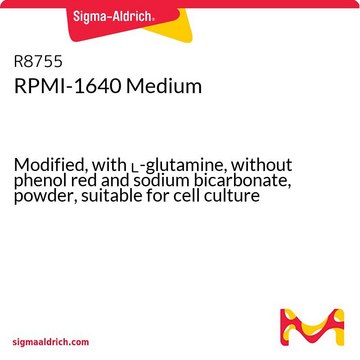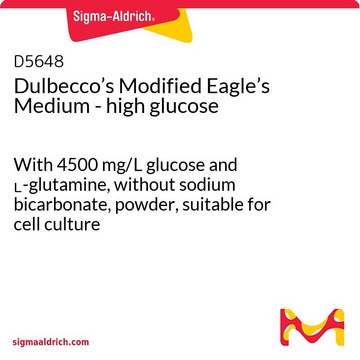R4130
Medio RPMI-1640
HEPES Modification, with L-glutamine and 25mM HEPES, without sodium bicarbonate, powder, suitable for cell culture
Fabricación farmacéutica
Iniciar sesiónpara Ver la Fijación de precios por contrato y de la organización
About This Item
Productos recomendados
Quality Level
form
powder
technique(s)
cell culture | mammalian: suitable
components
L-glutamine: yes
NaHCO3: no
phenol red: yes
HEPES: 25 mM
sodium pyruvate: no
shipped in
ambient
storage temp.
2-8°C
¿Está buscando productos similares? Visita Guía de comparación de productos
General description
El medio RPMI 1640 lo desarrolló el equipo de Moore en el Instituto Roswell Park Memorial en 1966. Se formuló una modificación del medio McCoy 5A para sostener las células linfoblastoides en cultivo en suspensión, pero desde entonces se ha demostrado que sirve de soporte para una amplia variedad de células que necesitan anclaje. Originalmente indicado para utilizar con un complemento sérico, se ha demostrado que el RPMI 1640 respalda diversas líneas celulares en ausencia de suero. También se ha utilizado ampliamente en protocolos de fusión y en el crecimiento de células híbridas. Este medio es adecuado para el cultivo de leucocitos humanos sanos y neoplásicos.
Quantity
Formulado para contener 16,4 gramos de polvo por litro de medio.
Reconstitution
Enriquecidas con 2,0 g/l de bicarbonato de sodio.
Storage Class
11 - Combustible Solids
wgk_germany
WGK 2
flash_point_f
Not applicable
flash_point_c
Not applicable
Elija entre una de las versiones más recientes:
¿Ya tiene este producto?
Encuentre la documentación para los productos que ha comprado recientemente en la Biblioteca de documentos.
Los clientes también vieron
Ana M S Cardoso et al.
Human molecular genetics, 28(16), 2738-2751 (2019-05-16)
Glioblastoma (GB) is the most aggressive and common form of primary brain tumor, characterized by fast proliferation, high invasion, and resistance to current standard treatment. The average survival rate post-diagnosis is only of 14.6 months, despite the aggressive standard post-surgery treatment
Jayant Dewangan et al.
Apoptosis : an international journal on programmed cell death, 22(10), 1246-1259 (2017-07-28)
Resveratrol (RES) is a natural polyphenol having anti-proliferative activity against breast cancer cells. RES in combination with other chemo modulatory agents, minimizes toxicity and increases efficacy of the treatment. Salinomycin (SAL), a monocarboxylic polyether ionophore is known for selectively targeting
Shilpee Sharma et al.
The Journal of biological chemistry, 293(30), 11687-11708 (2018-05-19)
HIV-1 subtype C (HIV-1C) may duplicate longer amino acid stretches in the p6 Gag protein, leading to the creation of an additional Pro-Thr/Ser-Ala-Pro (PTAP) motif necessary for viral packaging. However, the biological significance of a duplication of the PTAP motif
Michael D Lewis et al.
The American journal of tropical medicine and hygiene, 81(6), 1041-1049 (2009-12-10)
Trypanosoma cruzi, the agent of Chagas disease, can be subdivided into six discrete typing units (DTUs), TcI, TcIIa, TcIIb, TcIIc, TcIId or TcIIe, each having distinct epidemiologically important features. Dozens of genetic markers are available to determine the DTU to
Sven D Willger et al.
PLoS pathogens, 4(11), e1000200-e1000200 (2008-11-08)
At the site of microbial infections, the significant influx of immune effector cells and the necrosis of tissue by the invading pathogen generate hypoxic microenvironments in which both the pathogen and host cells must survive. Currently, whether hypoxia adaptation is
Nuestro equipo de científicos tiene experiencia en todas las áreas de investigación: Ciencias de la vida, Ciencia de los materiales, Síntesis química, Cromatografía, Analítica y muchas otras.
Póngase en contacto con el Servicio técnico





